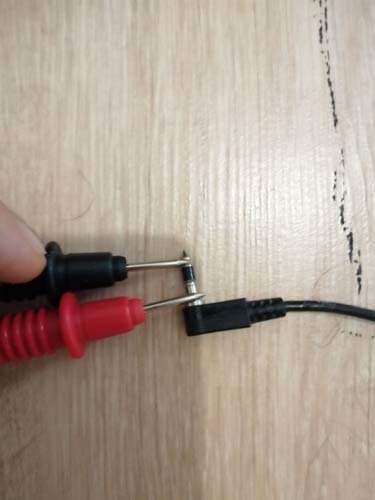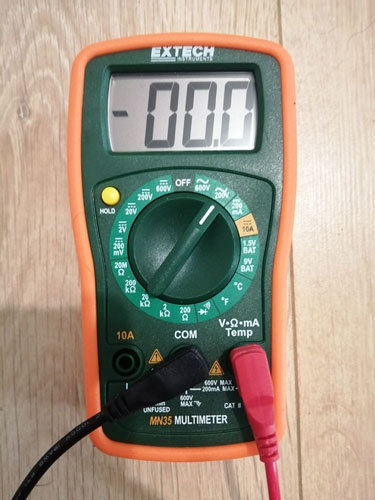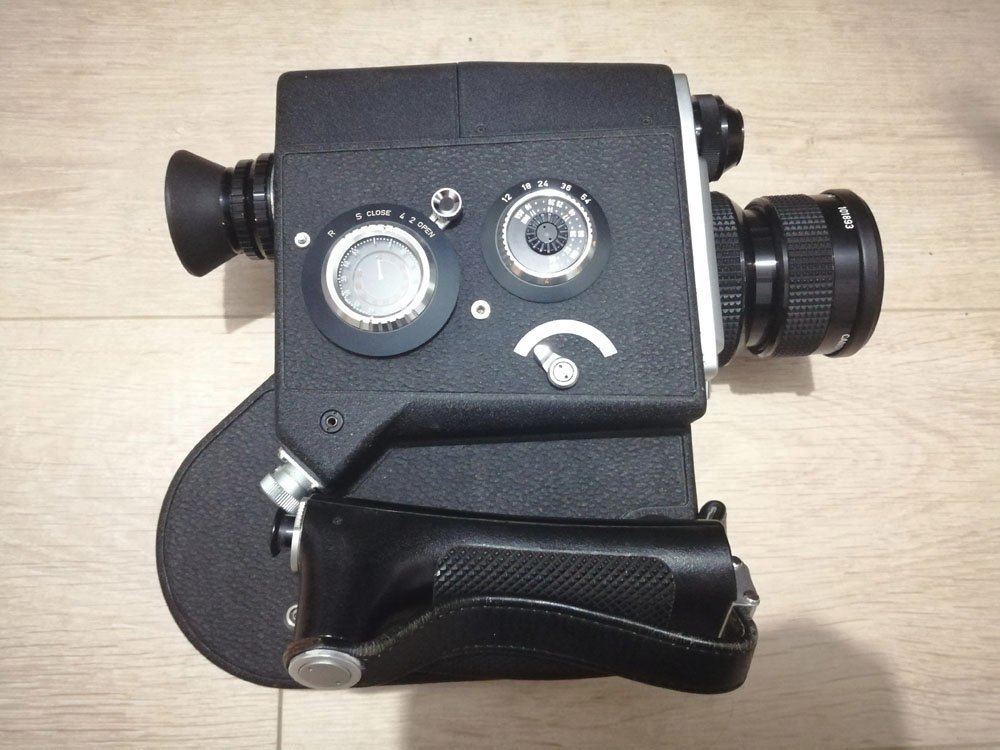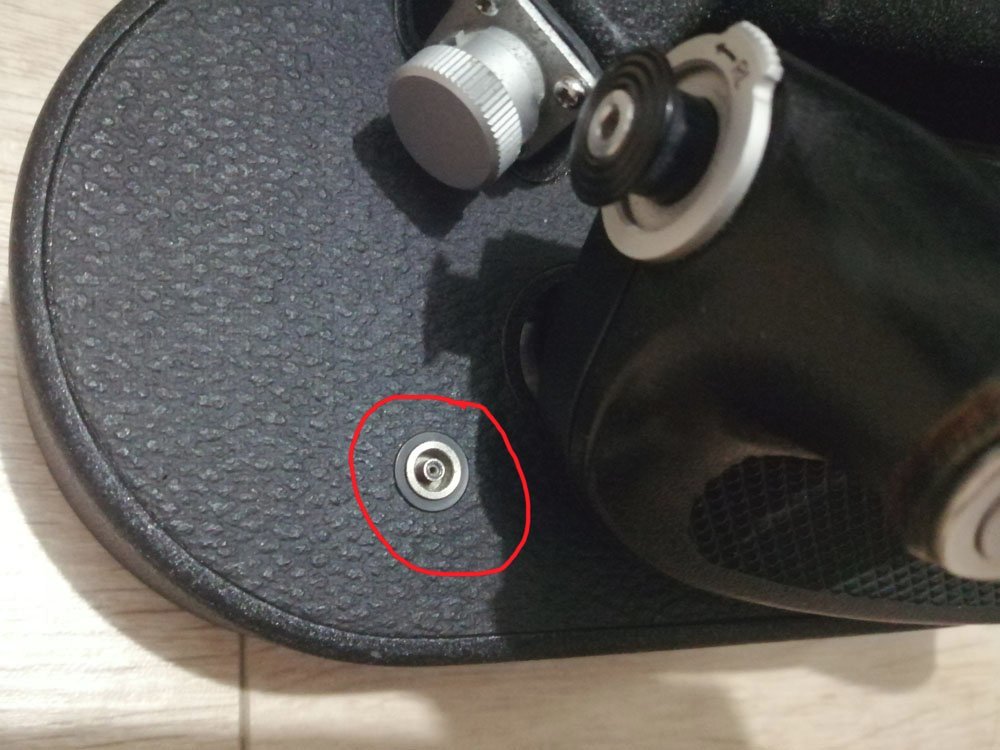-
Posts
29 -
Joined
-
Last visited
Posts posted by Jeremy Saint-Peyre
-
-
Hello everyone,
I am home processing 16mm, mostly Fomapan R100, and i am also home brewing my chemistery (hardening bath, bleach, clearing, developper is a photo paper one) : Sulfuric Acid, Potassium Permanganate, Potassium Alun, Sodium hexametaphosphate, Sodium Bisulphate and Sodium Metabisulphite.
I use caoutchouc gloves (the pink kind you use for house cleaning) and safety goggle.
My question is more about the mask and filter, i use this mask : https://www.cazabox.com/47353-demi-masque-a-filtre-nu-avec-soupape-d-expiration-sup-air.html and those filters : https://www.cazabox.com/7160-galette-filtrante-ammoniac-en14387-vendu-par-2-sup-air.html.
What are your opinions/gear ?
Thanks,
Jeremy -
On 11/29/2021 at 6:25 PM, Helge Landgraf said:
Hello,
I'm new to this forum, however I might be able to provide a proposal for a more simple solution.
Just attach a triggerable pulse mode frequency generator like this one to the camera's flash socket:
"PWM Impulse WSFG-06 20mA High Accuracy Signal Generator Multifunctional Adjustable Module for Pulse Mode" from Jeanoko (~30$).
It will generate a 1000Hz Impulse on every picture. Connect it's output to a free input of your digital audio recorder (if it has only 2 you'll have to sacrifice stereo sound for now).
Now set the output level of the little generator pretty high. Also set the trigger on your digital recorder for that input (if separately possible, if not also ok) pretty high and set it for automated recording, triggered by the input.I have a Tascam DR40 with 4 channels, I sacrificed one of the additional microphone inputs for that.
Also I did set the pre-recording to 2 seconds, means that the digital recorder will always have 2 seconds of sound recorded before the actual trigger event, which avoids that upon starting the camera anything could be lost.
By using that generator and by using 1000Hz pulses (1 for ea picture) you are gaining a lot of benefits:
- You don not need to deal with any electronics that can actually mimic the protocol needed to trigger the real remote or any fooling with the record button or similar - you just do not need any of those neither do you need to start the recorder manually
- You are now compatible with a lot of sync appliances available for syncing sound and picture upon projection (in case you consider projection), like the Visacustic system
- Using an audio editing tool like Audacity allows you to cut your recording (eliminating the recorded areas between actual takes) and to evaluate the number of pictures vs time
I use the Tascam DR40 together with a Nizo S8 camera (Nizo Professional) that has already an output of one 1000Hz pulse per frame, and it works fine.
Thank you Helge, i'm discovering your solution, i'll look into it ! Sorry for the late reaction...
-
Hello everyone !
I was on a trip but now i'm back at it. I will carefully read ad try to understand Phil and Aapo post. I've just ordered the Arduino Nano 33 IdO and an Arduino Uno kit ! -
18 hours ago, Phil Rhodes said:
Any of them, but for this I'd just get an Arduino Nano, or any of the clones of them. They're trivially inexpensive. You need a 3.3-volt version, not a 5-volt version, to talk to the Zoom recorder.
The thing is, just getting the board itself is only part of the story. You'd need to write some code to control the recorder, and if this is your first time it'll be a bit of a process. That might be OK if you didn't mind making a project out of it.
There's enough information available that I could try to do it remotely, but without being able to test with the real recorder it's tricky.
Thank you for the informations ! So i guess this one will do the job :
https://www.distrelec.ch/en/arduino-nano-33-iot-arduino-abx00027/p/30150883?no-cache=true&marketingPopup=false&queryFromSuggest=true
I did some arduino based project... but i was more on the cutting/screwing/assembling parts side. I am aware of the code side, so i'll put my mind at it, and if you can help a bit i'll be thankfull !
I'm also sourcing materials and arduino for an other project, a telecinema based on Denis Carl (http://www.deniscarl.com/dokuwiki/doku.php?id=start) opensource telecinema and on a version done by a friend. So, i have no choice but to put myself into coding ! -
43 minutes ago, Andries Molenaar said:
Clearly it is. The camera shorts the terminals in the connecting point. Take it from there. Best were to find a Sony Walkman with recording opion or a MiniDisc recorder withproper input. Possibly a Digital recording thing wiht a simple iinput exits.
I would not start a project of constructing a digital apparatus using Arduine and what more. You will never win back the time and effort.
simplest were to record just using a shart ahead, a clapper thing and stop after the scena was filmed.
Good luck.That would have been my choice if i wanted to shoot fiction, but i'm looking to shoot documentary, so i can't clap before/after a shoot in those conditions...
-
5 minutes ago, Andries Molenaar said:
INdeed, the physical apperance is less important ? The cameras supplies a shorting switch. It connects the terminals when running. On classic taperecorders the remote was a switch in serial with the switches in the recorder.
That is foreign language to me ?
-
6 minutes ago, Phil Rhodes said:
Well, yes, as Andries says, just connected together. That's what I'd expect.
Controlling the Zoom recorder is a little more complex. If I had one here I'd set up an Arduino to do it for you then it'd all be easy, but I don't.
P
Thank you, so if you both think it is still doable, i'm going to get in it. As i don't know where to start, wich arduino card should i use in your opinion ?
-
21 minutes ago, Andries Molenaar said:
The manual states that the connector can control a tape recorder. In that era it means it will short/connect the terminals when the camera runs. This would be connected to a remote control 2.5mm input of a recorder. On single frame it is fairly useless. ALthough the test flash demonstrates that the camera is working properly.
The trick is now to find a recorder which takes such a control or fix two wires inside a recorder or existing remote control with a button when pushed makes it record ?Thank you for your expertise ! My Zoom H4n do take remote control 2.5mm input, but i have doubt it'll work by plugin it in directly. Also i wanted to stop both recording simultaneously.
-
15 hours ago, Phil Rhodes said:
It'll likely be connecting the pins of the socket together, as opposed to emitting a voltage.
Thanks, i am not sure i get what it means... The pins are connected mechanically at the moment i trigger the camera ?
-
Hello everybody !
Sorry for the silence, i was looking to put my hand on a multimeter to test the socket on the camera !
So, i know the socket work because i plugged a flash in and it worked :So, to go further in this little project, i just had to mesure the electric power on the flash cord plugged in the socket according to Phil Rhodes, we need to know if it is a a short impulse or a continuous delivery. Here is the multimeter, i put it on 200V AC:

here is the cord :
It got me and absolute ZERO :

So i guess, my question is : What am i doing wrong ? -
8 minutes ago, Andries Molenaar said:
It is serial with a protocol, judging by the features. Design for that. Good luck.
What do you mean ?
-
26 minutes ago, Andries Molenaar said:
Sounds good. Then the mission is to find a recorder with a simple remote input, if these exit. Find a cable from and old flash and connect it to the recorder using a 2.5mm or what is to be found on it.
The H4n do have a remote input as there is a remote available : https://zoomcorp.com/en/gb/accessories/power-accessories/rc4/
It may be a 3.5mm, but if needed, an adapter 3.5mm to 2.5mm should do it. -
18 hours ago, Phil Rhodes said:
You could make it bleep, although I'm not sure that's essential in a situation where the H4n recorder will create a file for each take automatically. You'll just get a bleep at the start and end of every file. To do that you'd have to route your audio through the controller, too, which might risk adding noise to it.
You would inevitably need some level of electrotechnical ability to do this. I would happily do it as a fun little project, but I don't have a Zoom H4n Pro or a DS-8 camera. You don't really need the bluetooth features, that's designed to make it wireless. You're probably happy with a wired control for this application.
The camera side of it may be quite simple - is that just a closing contact? Does it close the contact once per frame, or something like that? Can we obtain a compatible cable?
The H4n side is a little less simple and requires sending some serial bytes to the recorder to control it. It's not hard, it's a day's work, but I would hesitate to try to do it without the recorder available to test.
Phil
Allright, i going to try your option, it seems it can be done relatively quickly and it would give me what i need (start and stop the audio recording according to the camera)
I do not know if it is just a closing contact... how can i know that ? Plug a cable, make the camera run and use a multimeter to see if there is short hight tension or a continuous one ?
For the cable, i may have an old canon synchroflash cable with 2.5mm on one end. Otherwise, here are some options :
https://www.bhphotovideo.com/c/product/1332403-REG/pluto_pc_cable_flash_pc_sync_cable.html
https://www.bhphotovideo.com/c/product/1015044-REG/nero_trigger_cable_flash_cable_for_flash_units.html
https://www.bhphotovideo.com/c/product/1494317-REG/tentacle_sync_c20_gh5s_tentacle_to_flash.html
https://www.missnumerique.com/miops-smart-cable-de-declenchement-pc-sync-pour-flash-p-29013.html
And for the H4n side that is less simple, where should i start ?
As the previous board is sold out, would this one https://store.arduino.cc/collections/boards/products/arduino-nano-rp2040-connect (also a 3,3v) do it ?
I still aim to shoot remotely in the wil, so this mean the board would take it's power from the camera ?
From what i understand from the GitHub page, the only thing i need beside the arduino board are the cables ?
Many thanks !
Jeremy -
17 hours ago, Andries Molenaar said:
Well, if the Canon has a flash contact to flash every frame it is not intended to control a recorder. You are in for a lot thinkering.
If it were a short-contact to drive a recorder it could drive cassettes or tape recorder. It seems digital recorder don't have the same simple shorting inputs. Simplest might be to fix two parallel to the RECORD button and possibly find a place for a receiver-connector on the hill.
That might work on the simple Olympus dictaphone here. It would deliver superior audio in comparison to ancient tapes ? Possibly the more expensive one might have remote control input, intended for listening back by the typist.
Another option might be to use a portable MINI-DISC-drive. Digital and stereoWell, it is said in the user guide that the flash socket can be used to trigger sound recording, so it was intended in the camera engineering (here on page 28 https://www.manualslib.com/manual/553933/Canon-Zoom-Ds-8.html?page=28#manual). Also, it is true there is a single frame releases possible, the socket is clearly described as a "tape recorder starting socket" (page 3 of the manual). I think you can use it to trigger flash when you do single frame release, and there is also a special socket for "single frame release socket", it is nowhere said in the manual that you can trigger flash, i am just guessing from the socket. On my 814 XL-R there is this possibility, so i assumed it is the same on the DS-8. But it seems i was wrong.
-
40 minutes ago, Phil Rhodes said:
The feature is described on page 43 of the operation manual: "Optional remote control operation." The optional RC4 controller is required.
It would be necessary to reverse-engineer how the RC4 controller talks to the H4n Pro (or get that information from Zoom) and implement that, which, I would wildly guess, is probably workable.
Oh - edit - it's absolutely workable, someone has already done it:
https://github.com/gschoppe/Blueduino-RC4
Basically you could make a box that sits between the trigger port on the camera and the remote control on the H4n and does exactly what you want.
P
Allright, so, let's say i build this Blueduino-RC4 (this would be my cheapest option, as i already have my H4n (not the Pro version) and a microphone), i'd just have to plug it on my camera through the flash socket (it's a synchroflash, it's also used to trigger flash when you do stop motion) and it would trigger the recording on the H4n ?
It will be wired like this : Camera --> Blueduino --> H4n
The Blueduino being build on this : https://store.arduino.cc/products/arduino-nano-33-ble ?
I have absolutly ZERO knowledge in arduino and electrotechnics (but i can shoot homemade glassplate...), so i wonder how i will plug the Blueduino on the camera...
And also, i aim to use it in the wild, so without power.
Would it be possible to add aapo lettinen features (the sound bleep on start and end) to this solution ?
An other problem i'm going to have is i think the vibration from the camera and the noise can be a problem. I cleaned my recording to get rid of the camera noise, but it's heavily done, so i'll buil a blimp to get it if not sound proof, at least sound discret.
Thanks again,
Jeremy -
Whao, i wasnt expecting that much feedback in such a short time. I'll make some research based on your comment and i'll get back at you,
Thanks a lot ! -
Good evening,
I am the happy owner of a Canon Zoom DS-8. Close to the handle, there is a socket, according to the notice (here https://www.manualslib.com/manual/553933/Canon-Zoom-Ds-8.html?page=28#manual) you can trigger a tape recorder simultaneously with the shutter realease, if the remote control cable from the recorder is connected to the camera. The recorder power should be at maximum 24v /0.3A.
I succesfully post synchronised 30sec interval by clapping my hands while recording with my H4n nearby, results here (in french...) :
My goal is to have an on camera microphone with a digital recorder triggered by the camera... The cherry on top of the cake would be to have the sound recorder to stop record when the shutter realease button is reasleased.
I have no idea where to start. I guess i should invest in a basic recorder on wich i can plug my Rode microphone ?
I am a photographer, i'm kind of new in the movie camera/sound sychro game so any opinions or leads are welcome !
Thanks !
Jérémy -
-
Hello Martin !
Thanks for your answer, I'll give it a try this way with the crystal synch of the camera. My main problem is I want to shoot documentary, so I can expect segment with more than 1min. But, I can take an other artistic direction to cheat that issue.
How would you proceed to fill out the gate ?
Many thanks,
Jeremy -
Hello folks,
I just got an email from Pro8mm that they do not offer the 24fps crystal synchro and max 8 film gate modifications.
Do any of you know how/where I could get both done at once or separately ? In Europe if possible...
Thanks very much
Jérémy -
Yeah, me too, especially it went succesful before.
I was suggested on an FB group and o Photrio as well that the bleach A and B concentrations are too high. Sulfuric acid should be at 1% and lowering Permanganate potassium to 2gr/L (or even less at 1gr/L) instead of 4gr/L for 5min...
Dichromate are now forbidden to sell and/or to own du to toxicity in UE. That's why i got into de Potassium Permanganate/Sulfuric Acid bleach. -
Hello guys and gals,
So, yesterday, while processing some Tri-X Super 8, something nightmareish happened during the second developpement after re-exposure : after 1 min in the 2nd developer (where the emulsion properly reacted and darkened), it slightly started to lift from the plastic and then it litteraly disloved into the developper : no floating gelatin flakes, just a plain black developer...
The weird thing is that I already processed Tri-X this way, here is an example : https://vimeo.com/326184819Here is my protocole, I have included as much info as I can :
1 – Soaking in a 25°C water bath.
2 – 1st Developer : Ilford Multigrad 1+9, 20min (continuous agitation on 1st minute, then 10sec each minute), 25°C.
3 – Hardening stop bath : Adox EcoStop 1+29 + 40ml/L of Tetenal Hardener. 6 min, 20°C, continuous agitation. (https://www.fotoimpex.com/chemistry/tetenal-hardener-to-be-added-to-the-fixer-or-stop-bath-1000-ml.html?cache=1564733928)
4 – Washing, runing water, 2 minutes.
5 – Bleach : Potassium permanganate 0,4% + Sulfuric Acid 10% equal part, 6 min, 20°C, continuous agitation.
6 – Washing, runing water, 2 minutes.
7 – Clearing bath, Sodium metabisulfite 6%, 2 min, 20°C, continous agitation.
8 – Washing, runing water, 2 minutes.
9 – Hardening stop bath : Adox EcoStop 1+29 + 40ml/L of Tetenal Hardener. 6 min, 20°C, continuous agitation.
10 – Washing, runing water, 2 minutes.
RE-EXPOSURE : 2x1min 80W 1m in a white tank filled with water.
11 – 2nd Developer : Ilford Multigrad 1+9, 4min (stand), 25°C. The same solution I used as 1st developer. And that's where the emulsion dissolved....
Usually, after that, I use an hardening fixer for 5 minute, washing 10 min on runing water, rinse with distilled water, let it dry and digitalise with a Retroscann Universal.
It's fastidious, but cheap !
Side notes :
- Processing in Lomo Tank.
- I know Ilford says not to use Ilford Multigrade for processing film (Universal PQ is recommanded instead), but through my test phase it was the only thing I had on hand, so I tried and it worked as you could see on vimeo.
- I've never found any information about the shelf lif of the Tetenal hardener. As it is supposed to be mixed with Stop or Fix, I mixed it with the Adox Eco Stop to be sure I won't use an hardening bath tha is no longer working. Anyway, I mixed a new solution and it was still a disaster.
- I use the hardener to compensate the softening of the emusion by the bleach. One bath before to strenghten, one bath after to reinforce. I thing the bleach isnt to blame, otherwise it the continous agitation in the clearing bath would have the same mechanical effect, so I guess it is a chemistery issue. The film is perfectly fine during re-exposure, bleaching is complete, after touching the film, the emulsion is normal.
- I dont know why the developper is dissolving the emulsion on second use but work perfectly fine on the first one.
So that's it, if anyone have an idea, i'm all ears !
Thanks !
Jérémy
-
-
thanks, finally, it was an unexposed black and white...






Triggering a digital audio recorder on a Canon Zoom DS-8
in Super-8
Posted
I'm back on my feet ! Thanks for the idea Helge, do you have any exemple that you shot with your Nizo and the PWM Impulse WSFG-06 i can look at ? I like how the idea is simple and elegant.
How does the pre-recording actually work ? Doesn't it make it hard to sync with the footage in post ?